Encountering an animal during the night can be an intimidating experience, particularly if that animal is a predator. And while most nocturnal animals just want to go about their business, several nighttime predators are particularly dangerous. These apex predators roam the darkness and wreak havoc on unsuspecting prey — but their identity may surprise you. Here are the seven most dangerous nocturnal predators in the United States.
1. American Badger
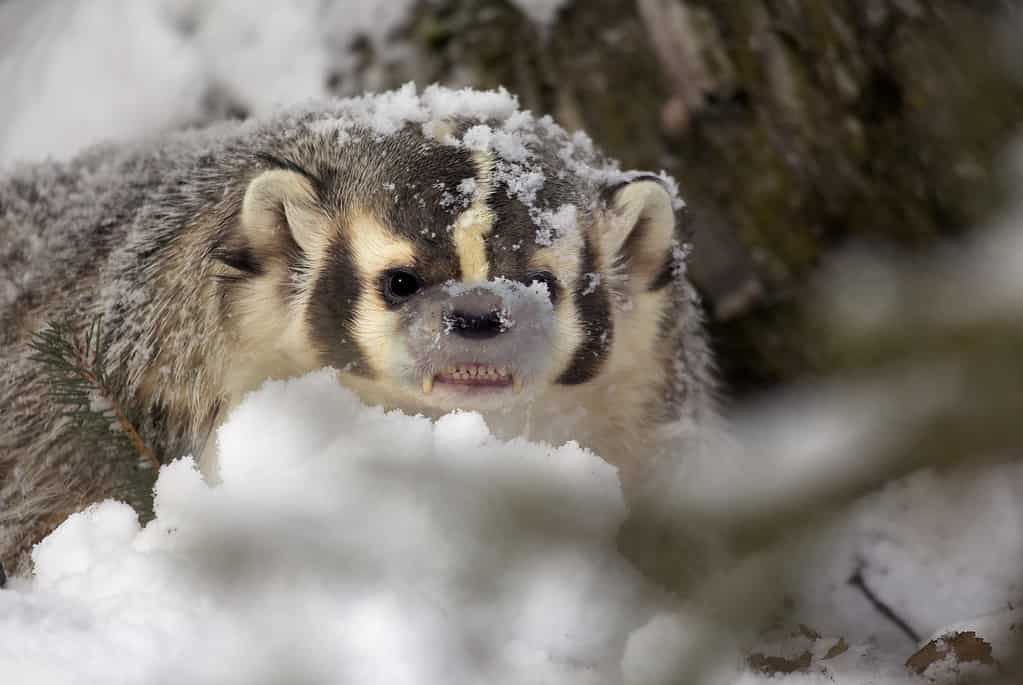
While the badger’s eyesight isn’t strong, their sense of smell is unusually good.
©moose henderson/iStock via Getty Images
The American badger may not look formidable with its short legs and puffy coat, but it is no pushover. In fact, the loose, thick fur that makes them look so soft actually helps them evade other predators. When a badger is caught, the loose skin allows them to turn around and fight back with its teeth and claws. Luckily for the badger, they have few natural enemies and are usually on the top of the food chain. When badgers feel threatened, they can become aggressive. They release a foul-smelling musk to deter threats. They will also growl, hiss, bare their teeth, and even attack.
Badgers have thick, long claws that they primarily use for digging when they search for prey. Once they find their next meal, their strong jaws and sharp teeth help them easily crush bones and overcome the animal. In fact, badgers’ jaws are so strong that they have a greater bite force quotient than many larger animals, including American black bears.
Strictly carnivores, the American badger’s diet consists primarily of small burrowing animals including mice, ground squirrels, prairie dogs, gophers, and insects. The badgers are such good diggers that they are the only predator that can excavate the burrows of deep-digging pocket gophers.
2. Mountain Lion
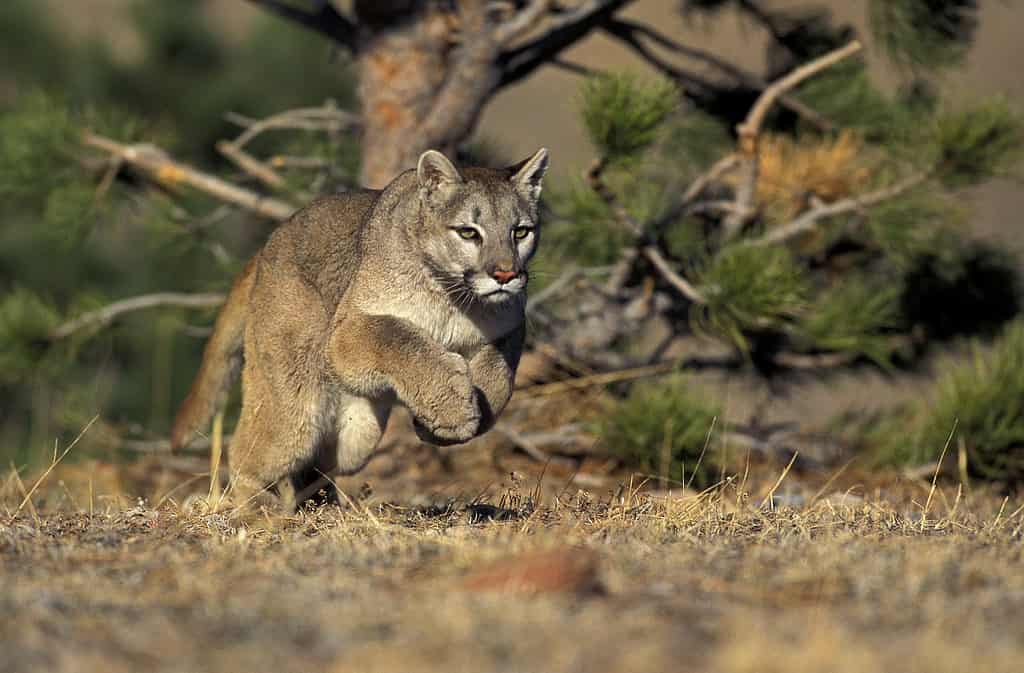
Mountain lions can reach speeds of up to 50 miles per hour over short distances.
©iStock.com/slowmotiongli
North America’s lion is an intimidating animal. While not actually in the lion family, mountain lions (also known as cougars, pumas, panthers, or catamounts) are the second-biggest cat in the Americas, after the jaguar. Weighing 90-175 pounds, these big cats easily bring down white-tailed deer, which make up the majority of their diet. In addition to white-tailed deer, the opportunistic mountain lion also eats elk, mountain goats, raccoons, coyotes, mice, rabbits, turkeys, and even porcupines.
Mountain lions are ambush hunters and like to sneak up on their prey. When they attack large animals, they usually go for the neck. This is because their jaws are powerful enough to break the necks or strangle the windpipe of large prey such as deer, allowing them to incapacitate the animal immediately. These strong jaws contain 30 teeth, including razor-sharp 2-inch-long canines. They also use their 18 2-2.5-inch retractable claws to help bring down their prey.
All in all, a lion can eat around 20-30 pounds of meat per meal. One study found that on average, mountain lions killed 56 small and 48 large mammals per year. After killing a large animal, the cat eats what it wants and then caches the remainder of the prey so they can come back for another meal later. They will return to the same carcass to feed for up to 10 days, or until it is gone.
3. Great Horned Owl
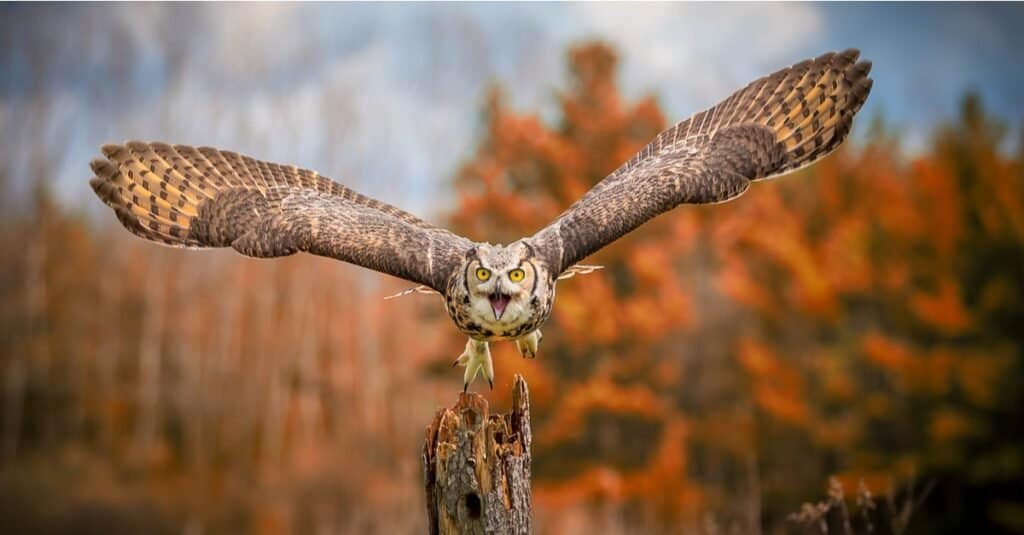
A great horned owl’s grip strength can be up to 500 pounds per square inch.
©Imran Ashraf/Shutterstock.com
One of the largest owls in North America, the great horned owl is an apex predator. Adults have no real natural threats, though eggs and nestlings are vulnerable to predation from other raptors, crows, raccoons, and other animals. Not much scares a great horned owl, including skunks; the owl’s sense of smell is so poor that it isn’t deterred by a skunk’s odor. In fact, skunks are a favorite meal of these big owls.
Great horned owls are impressively strong and are able to kill and carry prey that is larger and heavier than the owl itself. They have been known to carry prey that is eight to nine pounds — despite the fact that the owl only weighs 3.2 pounds on average. This is possible thanks to their impressive grip strength of up to 500 pounds per square inch, nearly 10 times stronger than that of a human and similar to the bite of a large dog.
Great horned owls also have large talons that measure around 2.5 inches long. When an owl clenches these talons, it takes up to 28 pounds of force to open them, giving prey little to no chance of escaping.
4. Mink
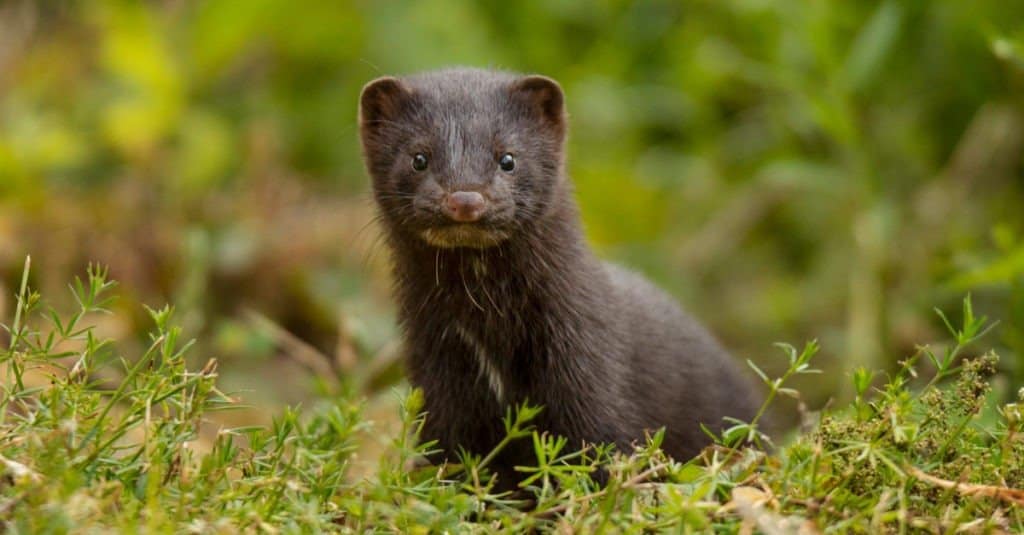
Male mink can exceed 2 feet in length.
©An inspiration/Shutterstock.com
The semiaquatic mink is a formidable predator on both land and water. Territorial predators, they typically set up a stationary den near rivers or creeks where they can hunt fish, muskrats, other rodents, crustaceans, birds, and amphibians. Thanks to their streamlined shape, minks are fast on land, adept swimmers, and can climb trees, so few animals are safe from them. They also have great stamina and can swim in warm water for up to three hours straight.
While not overly large, minks are small but mighty. Measuring around 2-2.5 feet long and weighing just three pounds, they are more ferocious than their size implies. They are extremely territorial and aggressive and will fight — and kill — animals that are much larger than them. In fact, they can be so vicious that they have few natural predators besides humans, who harvest mink for their soft fur. To kill their prey, they will bite it on the throat with their powerful jaws.
While many predators only kill what they need immediately, a mink takes as much as it can get. If a mink finds plentiful prey, it will kill as many animals as possible and cache the extras. This can cause huge problems when they get into domestic enclosures such as chicken coops, as they will take out far more chickens than they need.
Timber Rattlesnake
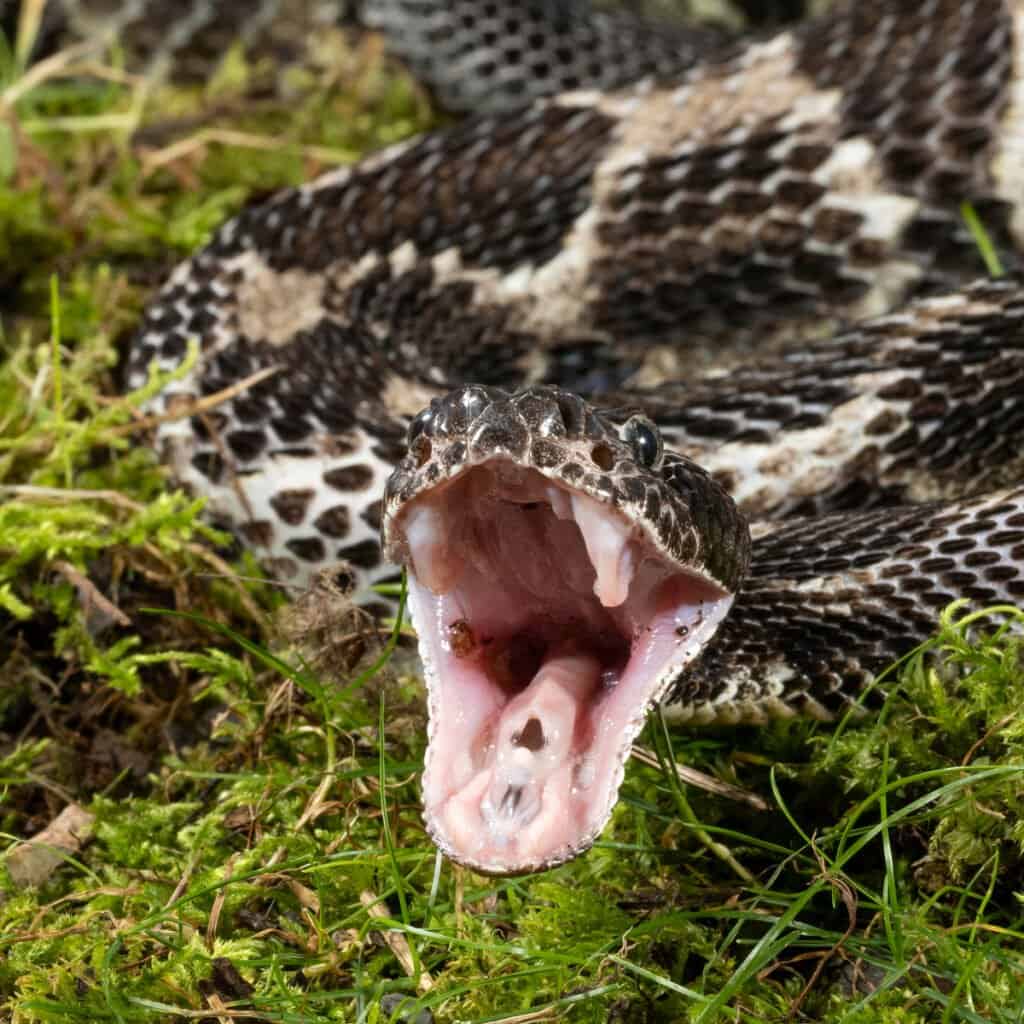
When daytime temperatures are hot, rattlesnakes become increasingly active at night.
©Joe McDonald/Shutterstock.com
While timber rattlesnakes are typically diurnal during spring and fall, this snake prefers to avoid the midsummer heat. During the summer, timber rattlesnakes will often become more active at night and hunt nocturnally. High temperatures can be dangerous for snakes, so the rattlesnake changes its activity to avoid the hottest parts of the day.
The timber rattlesnake is a viper that is venomous enough to kill a human, so smaller animals are no match for the snake’s bite. The neurotoxin in the snake’s venom causes the prey’s blood pressure to plummet and induces respiratory paralysis. The snake can then ingest the prey, swallowing it whole, whether or not it is already dead. Favorite meals for rattlesnakes include squirrels, mice, small birds, amphibians, rodents, and other small animals.
Rattlesnakes are ambush predators that wait silently and completely still for prey to pass by. They will then strike with speed, biting and injecting the prey with venom. A timber rattlesnake is incredibly fast and strikes at speeds of up to 2.95 meters per second, or about 6.5 miles per hour. Adult timber rattlesnakes have an average length of 2.5-5 feet, but they can get bigger. The biggest timber rattler on record was 6.2 feet long. Despite this large size, on average 33.3% of the rattlesnake’s diet is made up of deer mice from the Peromyscus genus.
Bat
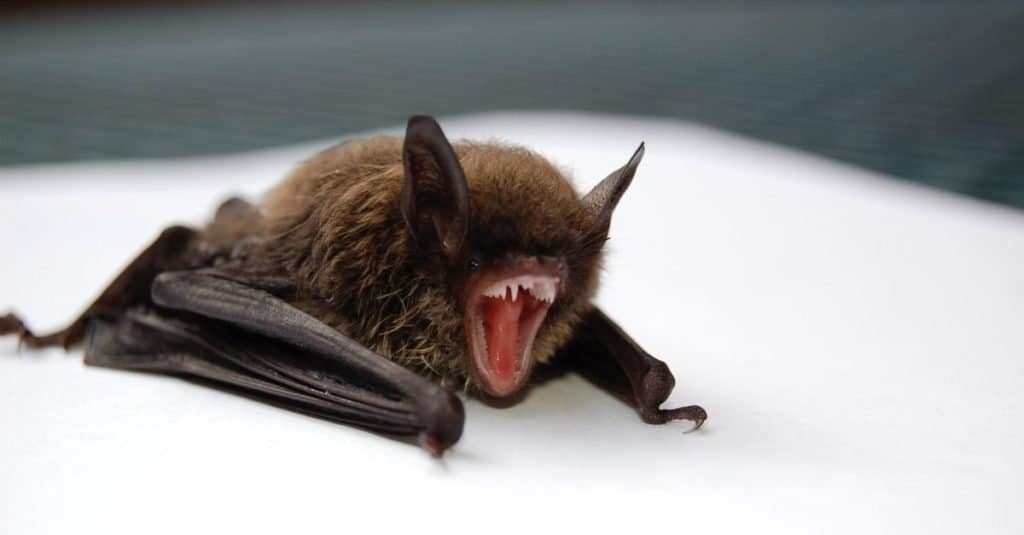
Little brown bats have 38 teeth, though some bat species only have 20.
©Daily-Images/Shutterstock.com
Bats may not seem that dangerous to people, but you may change your mind if you’re a flying insect. Bats are amazing predators that play a huge role in controlling bug populations. In the United States alone there are around 45 different species of bat. All of these species are insectivorous except for three. This means that most of the bats in the U.S. hunt insects for food.
And they are good hunters. Every night, a bat can eat its weight in insects. For little brown bats, this means eating up to 4,500 insects a night. Mexican free-tailed bats in Texas eat approximately 10 grams of insects nightly. Since the free-tailed bat lives in colonies of up to 15 million bats, this means a single colony could eat 165 tons of insects in a night — approximately the weight of a blue whale.
Bats are also incredibly fast. While species vary in speed, none of them are slow. Research found that some can reach speeds of over 100 miles per hour, making it easy for them to snatch insects out of midair.
Firefly

There are over 150 species of fireflies from 16 genera in the United States.
©iStock.com/ErikAgar
When you think of dangerous animals, it’s doubtful that fireflies come anywhere near the top of your list. But some species of firefly are actually adept nocturnal predators! Firefly larvae (sometimes known as glowworms) inject prey such as slugs, snails, and worms with numbing chemicals to disable them. After the prey is disabled, the larvae can eat at their own pace. Adult fireflies skip the snails and worms and instead eat other fireflies.
Since fireflies are small, there are plenty of other animals that would like to make a meal of them. To deter predators, firefly blood contains something called lucibufagins. This defensive steroid is produced in the firefly’s blood when it is under stress. The steroid makes the bugs unpalatable and tastes bad to animals like birds or spiders that try to eat them. A firefly’s bioluminescence (the light it gives off) can also deter other predators from pursuing it. The light serves as a warning display that helps ward off would-be predators, reminding them that the firefly tastes bad and should be avoided at mealtime.
Summary of 6 Most Dangerous Nocturnal Predators
| Animal | Dangerous Features |
|---|---|
| American Badger | Defensive animals with strong jaws that can crush bone with a greater bite force quotient than a black bear. |
| Mountain Lion | Stealthy ambush hunters with 2-inch-long teeth and 2.5-inch razor-sharp claws. |
| Great Horned Owl | Large birds that are able to carry 3 times their body weight with a grip strength of 500 pounds per square inch. |
| Mink | Territorial and aggressive, mink use their powerful jaws to kill as much prey as they can at once, caching whatever is extra. |
| Timber Rattlesnake | An ambush predator that strikes at 6.5 miles per hour to incapacitate prey with venom. |
| Bat | Speedy flyers that can reach speeds over 100 miles per hour and eat their body weight in prey every night. |
| Firefly | Larvae inject numbing chemicals into prey to incapacitate them; bioluminescence and defensive steroids in the firefly’s blood deter predators. |
The photo featured at the top of this post is © Annette Shaff/Shutterstock.com
Thank you for reading! Have some feedback for us? Contact the AZ Animals editorial team.






